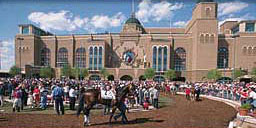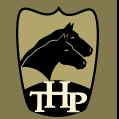|

|
 |
Q & A with Lone Star Park Track Maintenance Director George McDermott
(Grand Prairie, Texas - Tuesday, June 5, 2012) - The following question and answer session with Lone Star Park Track Maintenance Director George McDermott was conducted by THP Director of Race Terry Blanton. There have been a limited number of complaints concerning the track and turf surface at Lone Star Park. Every Thursday at 11:00 a.m. in the Texas Horsemen’s Partnership office at Lone Star Park, we hold a meeting with LSP Track Maintenance Director George McDermott and Assistant Director Aaron “Pee Wee” Pelt. In these meetings, horsemen that would like to discuss any concerns they may have concerning either surface have the opportunity. For those that do not have the opportunity to attend the meetings each Thursday, I sat down with George for a short interview. I hope his answers will help horsemen understand what track maintenance does to help the horses and riders run safely over both tracks: TB: How many years have you been at Lone Star Park? GM: I started at Lone Star Park on October 17, 2005. This will be my seventh year. I have been in the track maintenence area for 37 years. TB: I know you come over from Louisiana Downs. Tell us about your experiences with that track and any previous professional experience you’ve had that pertains to racing. GM: I served in the United States Navy Submarine Service. I went to Midlands Tec. under the GI bill after leaving the United States Navy and earned a Diploma in Heavy Equipment Operation Maintenance and Heavy Construction Blueprint reading. My background prior to racing was in construction and being a heavy equipment operator. I was hired at Louisiana Downs in May of 1975 as their equipment operator. That year, the racing surface was taken up and redone from the bottom up. I was involved in the entire operation to replace the racing surface. The track had its base redone, with a new surface applied. In 1978, the building of the turf track was my next project to help with. The infield was prepped for the turf track base, and sand and grass were installed. In 1980, I was named the assistant track superintendent to Track Superintendent Joe Souza. In 1991, I replaced Mr. Souza as track superintendent. TB: I know you visit several other tracks and attend seminars with other track superintendents visiting Lone Star Park. Please give us a run-down of who they are and why they visit this track. GM: I have been attending the Track Superintendents Annual Field Day for nine years. The NTRA credits each event with ECU for furthering track superintendents’ education in the field for track maintenance. In 2007, Lone Star Park hosted the event, with track directors from all over the country and beyond - even Australia and Dubai. I am a committee member in WSS Jockey Club on dirt and turf surfaces, ASTM (the international standard setting organization on equine surfaces), and a Safe Arena Footing (SAF) committee member for national rodeo events. I have assisted the following states in racing surface problems: New York (the state racing commission and the HBPA), Pennsylvania (the state racing commission and the HBPA), and Louisiana (the HBPA). I have also been interim track superintendent at Louisiana Downs and Beulah Park. I have consulted and assisted: Louisiana Downs (Louisiana), Arlington Park (Illinois), Oaklawn Jockey Club (Arkansas), Turf Paradise (Arizona), Penn National (Pennsylvania), Beulah Park (Ohio), Delta Downs (Louisiana), Gulfstream Park (Florida), Evangeline Downs (Louisiana), Hawthorne Race Course (Illinois), Prairie Meadows (Iowa), Santa Anita Park (California), Canterbury Park (Minnesota), Remington Park (Oklahoma), Prairie Meadows (Iowa), Retama Park (Texas), Fair Grounds (Louisiana), Calder Race Course (Florida), and Finger Lakes (New York). TB: Some folks think you run a harrow and a water truck over the track, and that’s it. Give us a quick run-down of a day in your job starting, with opening the track for training until the last race. What equipment do you use, and what testing equipment is used? GM: First, I will say that the track surfaces (dirt and turf) are tested two times a year through laboratories. I only use laboratories that test racing surfaces (Soil and Plant - Environmental Technical Services and a new one, Racing Surfaces Testing Laboratory). If results come back with recommendations, I will amend as needed. These labs give recommendations on fertilization schedules for the turf, as well. Maintenance of the racing surface starts at 2:00 a.m. My morning crew, with Aaron "Pee Wee" Pelt heading it up, is dedicated to getting the track ready for morning workouts. THE FOLLOWING IS ON A NORMAL RACE DAY WHEN ALL WEATHER CONDITIONS ARE GOOD
Turf Track
TB: What do you add to the track to maintain moisture levels? GM: The material on the main track has a level of silt and clay that retains most of the moisture. We add organic bark material at intervals to help in moisture retention. This bark material is special and used for the dirt surface. It is a special blend that I created and is used all over the country. This process has been used in dirt tracks for many years, and I found that it helps with moisture and gives life to the racing surface. TB: When we have rain, what is your schedule and procedure for taking races off of the turf? And why do you call them off early in the day? How does this help the horsemen? GM: After a rain event, the first thing we do is to check the rain gauge for the amount of rain we had in that event (here at Lone Star Park, not DFW). If it is over 0.25 inch, we get ready to take Clegg measurements after training. On early race days, this has to be done prior to 11:00 a.m., and for late racing, no later than 2:00 p.m. This gives horsemen plenty of time to adjust shoes for the main track. Walking the track - checking for proper readings and looking for unsafe areas - usually takes at least an hour and gives the turf crew plenty of time to correct any problem areas. In some cases, races have to be taken off due to unsafe racing conditions. This also lets the riders know of any harder or softer spots to watch out for. With over four years of data taken in Clegg readings, we can insure the safety of riders and horses. TB: Several horsemen believe that the turf is hard and not enough water is applied. Please explain the equipment and what you are accomplishing when you roll the turf. Could the rolling of the turf make it hard? What do you do to improve it? GM: Water is applied to attain the safest racing conditions. The Clegg gives an impact reading that insures the proper running areas for the horses. This level is checked daily, and water is applied after races to make the turf uniform. If moisture is not monitored, you can have soft or hard areas. All the data taken gives the irrigation man the exact amount of water to be applied. If too much is applied, we lose a race day. If too little is applied, the turf can become too hard and uneven. Wind causes many problems, so the irrigation man stays and watches the entire water irrigation event (he stays until the turf track is done!). The roller insures the turf is level after the horses run their race. As a horse hits the ground, it pushes the turf up slightly, making a slight hole in the ground. The roller only pushes in the opposite direction to aid in leveling back the turf. The roller has no added weight (water) to what you see. To insure against any compaction forming, either starting gate, mowers, people, horses, and the roller, a slicer is used. This slicer softens the ground without interfering with racing. This is done several times a week, and more if any area has a Clegg reading to indicate a hard area. This also aids in getting water, nutrients, and oxygen to the plant (turf). TB: We have also heard many comments that claim you are limited by track management. Does management limit the expenses and manpower to maintain and improve both dirt and turf tracks? GM: I have to say without reservation that management gives me whatever I need to maintain a safe racing surface. Drew Shubeck, our president and general manager, is dedicated to having a safe racing surface. Both tracks get whatever they need for safety. Drew has always said, "If you need it, get it." He is great to work for, and I have never had a better president and general manager. Watching budgets is important, but safety for riders and horses comes first. Last but not least, without my crew, none of this takes place. I cannot thank my crew enough for their dedication to a safe racetrack. Without a good crew, I would not be able to give riders and horseman a safe racing surface. TB: George, thank you for your time and answers. I hope this will help the horsemen to understand what all must be done to maintain a safe racing surface. Meetings to discuss any issues and concerns about either the dirt or turf track are held each Thursday at 11:00 a.m. in the Texas Horsemen’s Partnership office at Lone Star Park. Horsemen, this gives you an opportunity to receive answers directly from your track maintenance director. |
| Back to News |
BENEVOLENCE | BENEFITS | GROOM ELITE | PERSONNEL | LINKS | CONTACT US
